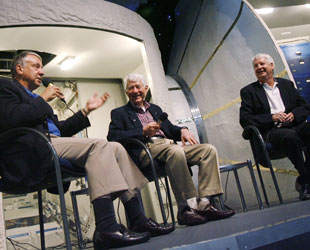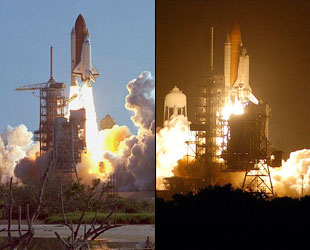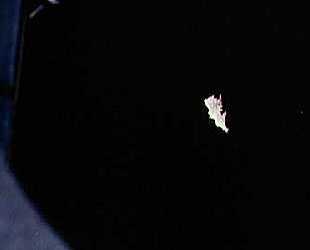August 30, 2009 — As space shuttle Discovery neared the International Space Station (ISS) on Sunday evening, its crew first caught sight of the sun's glare bouncing off eight pairs of solar arrays. The reflection spanned across both space and time, as it hearkened back to Discovery's maiden launch 25 years ago today and its 6-day mission then to test fly a large, lightweight solar wing.
Guided in by STS-128 commander Rick Sturckow and his crew of six, Discovery docked with the ISS at 7:54 p.m. CDT, just over a half day and quarter century after their spacecraft's first launch at 7:41 a.m. on August 30, 1984. Their evening arrival also marked the 30th time an orbiter visited the still-growing station.
For the members of Discovery's first crew, seeing "their" spacecraft still flying on its silver anniversary is a sight to relish.
"I'm very pleased with that," reflected STS-41D mission commander Henry "Hank" Hartsfield in an interview with collectSPACE. "I'm very glad to see that orbiter lasting."
Grand dame of the fleet
Discovery was NASA's third space shuttle orbiter to enter service, following Columbia and Challenger in 1981 and 1983 respectively. It is now the oldest surviving and most flown vehicle among the five orbiter fleet after the loss in flight of its two predecessors.
"I flew Columbia, Challenger, and Discovery," Hartsfield shared. "I was fortunate to be the commander of the first flight of Discovery, and it's turned out to be a pretty doggoned good bird. We had a few problems on that first flight but it's survived that and other things we had to fix along the way. The other two are lost so you know, I have but one left."

Charlie Walker, Hank Hartsfield and Steve Hawley reunite at the Kansas Cosmosphere (Credit: The Hutchinson News) |
Challenger broke apart 73 seconds into its 10th launch on January 28, 1986 as a result of a solid rocket booster's failed seal. Among the seven people lost that day was Judith Resnik, who flew as a member of Hartsfield's crew on the STS-41D mission.
Columbia was lost during reentry into Earth's atmosphere on February 1, 2003, 16 days after an impact it suffered during ascent compromised its left wing's leading edge.
"It's hard to believe she's the grand dame of the fleet," wrote STS-41D mission specialist Richard "Mike" Mullane in an e-mail to collectSPACE. "I'll hope to watch from my backyard to see her coming over on (or near) my launch anniversary and when I [do] I'll be wishing I was aboard."
Discovery, now flying its 37th mission, is delivering new science experiments and equipment to the space station, as well as completing the last crew rotation between the shuttle and ISS. Its history is rich with other firsts and lasts for NASA.
"I remember some of the remarkable achievements that Discovery has enabled, such as taking the Hubble Space Telescope and the Ulysses spacecraft to orbit in 1990," recounted STS-41D crewmate Steve Hawley. "Discovery also carried the first cosmonaut on a shuttle flight helping begin our in-space cooperation with Russia that continues to this day."
A challenging mission
"It was very rewarding and satisfying to be able to fly the first flight of a new vehicle," recalled Michael Coats, who served as Discovery's first pilot and today leads NASA's Johnson Space Center in Texas as its director.
Coats spoke to collectSPACE just after stormy weather had scrubbed his chance to see Discovery launch on its current mission. He returned to Houston before Discovery ultimately lifted off four days later on Friday, August 28.

Then and now: Discovery's first and 37th launches on August 30, 1984 and August 28, 2009. (Credit: NASA/collectSPACE) |
"Every launch is a thrill obviously, but believe it or not, it's actually much more difficult to watch a launch than it is to ride through one. Every time Discovery flies it is kind of a special feeling since I not only flew the first flight but I flew it on all three of my missions. I guess the primary feeling I have is that I can't believe it has been 25 years. It seemed like it was just yesterday," said Coats.
Discovery's maiden mission included the deployment of three satellites and a 100 foot solar array, the latter the precursor to the panels that now provide electricity for the ISS.
The mission also marked the introduction of several new shuttle systems and configurations.
"There were some major changes to [Discovery]. It didn't have tiles on its sides. It was the first to have thermal blankets [instead]," described Hartsfield. "Of course, they made that modification to the [water] dump nozzle, which is what gave us that problem with the icicle."
Instead of spraying harmlessly into space as intended, the crew's ejected wastewater clung to Discovery's side, creating a several foot-long ice formation. Hartsfield used the orbiter's robotic arm to knock the icicle free, earning him and his crew the nickname "Icebusters".

A wastewater icicle floats away from the space shuttle Discovery after being knocked loose by the 'Icebusters' (Credit: NASA) |
Despite that and other problems, including the first on-pad abort, Discovery's first crew still takes pride in its flight.
"I think it was a good machine," said Hartsfield.
"Every time any other crew flew it, as soon as they got back, I said 'I hope you didn't break my orbiter here,' said Coats. "You feel kind of possessive."
After STS-128 lands, NASA plans just two more flights of Discovery out of the six missions remaining for the space shuttle program.
"Someday (too soon) she'll be in a museum and I know I'll get a lump in my throat when I visit her," shared Mullane.
For Charlie Walker, whose flight on the STS-41D mission was the first for an industry-chosen payload specialist, Discovery's current flight underscores the potential of the U.S. space program.
"Seeing and knowing a spaceship, having flown and lived aboard her is a special experience. Seeing Discovery fly back to space for her 37th time makes me believe that this country can do almost anything it wants to do."
